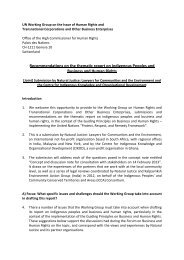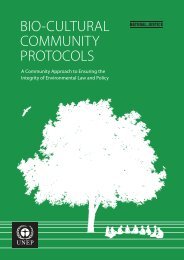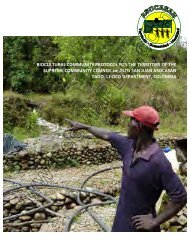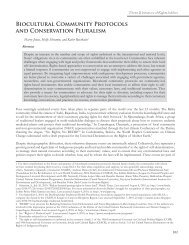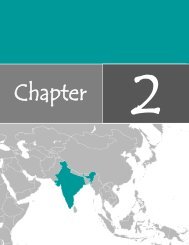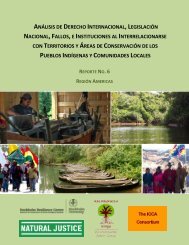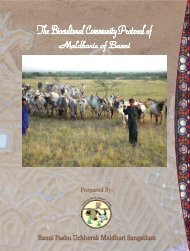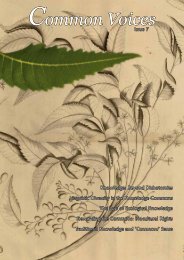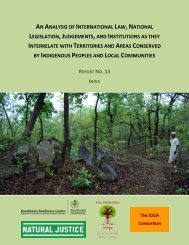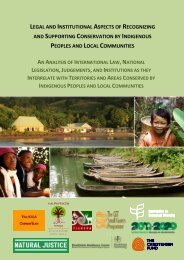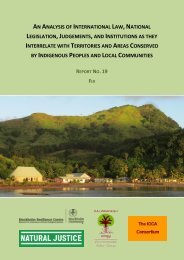Analyzing The Binding Nature of COP Decisions ... - Natural Justice
Analyzing The Binding Nature of COP Decisions ... - Natural Justice
Analyzing The Binding Nature of COP Decisions ... - Natural Justice
Create successful ePaper yourself
Turn your PDF publications into a flip-book with our unique Google optimized e-Paper software.
1. Introduction It is in the nature <strong>of</strong> human beings to organize our world into a hierarchical structure, whether it be with regard to leadership, sports teams, or—more prosaically—the classification <strong>of</strong> international laws. On the latter point, two simple categories have developed to organize international law into a hierarchical structure. At the top is so called “hard law,” 2 generally created by treaties, which theoretically imposes binding legal obligations on member states. At the bottom is “s<strong>of</strong>t law,” created by other instruments that theoretically are more in the nature <strong>of</strong> aspirational or moral goals. <strong>The</strong> operative word <strong>of</strong> course, is “theoretically.” It practice, it can be quite difficult to determine whether a particular instrument operates as hard or s<strong>of</strong>t law. 3One such instrument that is difficult to classify is the Convention on Biological Diversity (CBD) and its subsidiary instruments. In theory, the CBD is hard law, a binding international treaty negotiated by governments. In practice, however, it has been argued that the “CBD conforms to the characteristics <strong>of</strong> other international hard laws that possess a s<strong>of</strong>t nature.” 4This section explores the international legal context within which multilateral environmental agreements (MEAs) such as the CBD are developed. It then provides a brief description and preliminary analysis <strong>of</strong> the legal weight <strong>of</strong> the CBD. 52 Abbot, K.W. and Snidal, D., Hard and S<strong>of</strong>t Law In International Governance (2000) International Organization 54(3), 421 (defining hard law as “legally binding obligations that are precise (or can be made precise through adjudication or the issuance <strong>of</strong> detailed regulations) and that delegate authority for interpreting and implementing the law”). “<strong>The</strong> realm <strong>of</strong> ‘s<strong>of</strong>t law’ begins once legal arrangements are weakened along one or more <strong>of</strong> the dimensions <strong>of</strong> obligation, precision, and delegation.” Abbot and Snidal, at 422. 3 Some suggest that such a clear distinction between hard and s<strong>of</strong>t law may actually be a misnomer, given the process <strong>of</strong> compromise that leads to multilateral environmental agreements. Harrop, S.R. and D.J. Pritchard, A Hard Instrument Goes S<strong>of</strong>t: <strong>The</strong> Implications <strong>of</strong> the Convention on Biological Diversity’s Current Trajectory (2011) Global Environmental Change 21, 474-‐480, at 476 (citing DiMento, J.F.C., 2003. <strong>The</strong> Global Environment and International Law, University <strong>of</strong> Texas Press, Austin). 4 Harrop and Pritchard, at 476. 5 This section focuses on the CBD to address the complexity <strong>of</strong> this issue because the CBD “has emerged as the ‘primary instrument’ and the preferred international forum for indigenous and local communities to express their interests and demands for the protection <strong>of</strong> their traditional knowledge[.]” E. Morgera and E. Tsioumani, Yesterday, Today, and Tomorrow: Looking Afresh at



